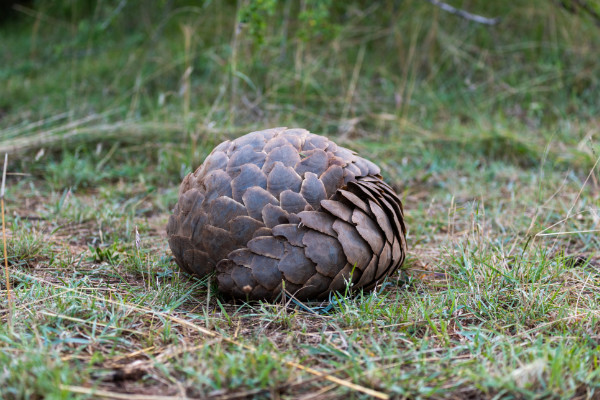Is it a pinecone? Is it an artichoke? No, it’s a pangolin, the quirky creature that lives across parts of Asia and Africa. Looking like a mashup of an anteater and an armadillo, pangolins are one of nature’s most confusing creations. They’re the only mammals wholly covered with scales from head to tail and are more closely related to cats, dogs and bears than their armadillo lookalikes. Confused and intrigued? So are we. Read on to discover more weird and wonderful pangolin facts.
Skillful scales
Believe it or not, humans and pangolins have something in common – our fingernails and their scales are both made of keratin. However, that’s where the similarities end. Pangolin scales contain beta keratin, which, simply put, means their scales are so strong that not even a lion can bite through them (beats any human manicure). When they sense danger, pangolins roll up into a ball, shielding their stomach and face with their sharp and sturdy scales. A stinky fluid is then released from the base of their tails, sending any prowling predators fleeing.

Pangolin species
A simple yet surprising pangolin fact is that there are eight species split across Asia and Africa. In Asia, you’ll find the Malayan pangolin, the Chinese pangolin, the Indian pangolin and the Palawan pangolin. Hop over to Africa, and you’ll discover the Ground pangolin, the Giant pangolin, the Cape pangolin and the Long-tailed pangolin (‘pangolin’ no longer sounds like a real word after all that). Each has variations in what habitat they call home and how they live, but they’re all identified by their signature scales.
Trafficking troubles
A pangolin’s scales may protect them from wild predators, but sadly they’re no match against human poachers. The insatiable demand for their scales, nails and meat makes pangolins the most trafficked mammals in the world. Around 300 pangolins are trafficked every day – that's around one every four minutes. The demand is highest in Asia, where the scales are believed to hold healing properties and their meat is considered a delicacy. Sadly, this means all eight species in Asia and Africa range from vulnerable to critically endangered.
Astounding appetite
Pangolins may be small, but their appetites are mighty. Consuming around 70 million ants, termites and insect larvae a year, these scaly mammals help control the insect numbers in their ecosystem – one pangolin can protect an area the size of 31 football fields from termite destruction. The pangolin’s sticky 15-inch tongue (longer than their bodies) slurps up these unsuspecting insects, burrowing deep into the ground to reach even the shyest of termites.
Dedicated introverts
You may – or may not – be wondering what the collective noun for these quirky creatures is. Luckily, our final pangolin fact answers it – there isn't one. Because pangolins tend to be solitary animals, active mostly at night and often living underground, groups aren’t much of a thing. They only meet once a year to produce a litter of one to three offspring, and their babies (known as pangopups) leave their mothers after about two years. Their solitary nature makes them some of the world’s best introverts, slipping under the radar of most people’s nature knowledge.
Written by Evie Buller.













